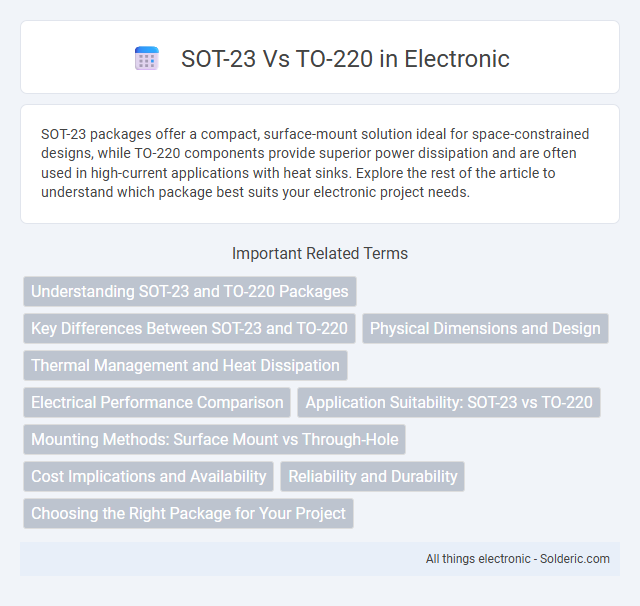SOT-23 packages offer a compact, surface-mount solution ideal for space-constrained designs, while TO-220 components provide superior power dissipation and are often used in high-current applications with heat sinks. Explore the rest of the article to understand which package best suits your electronic project needs.
Comparison Table
| Feature | SOT-23 | TO-220 |
|---|---|---|
| Package Type | Surface-mount, small outline transistor | Through-hole, larger power transistor |
| Dimensions | Approx. 2.9 x 1.3 x 1.1 mm | Approx. 10.16 x 15.75 x 4.57 mm |
| Power Dissipation | Typically up to 300 mW | Up to 50W or more with heatsink |
| Application | Low power, high-density PCB designs | High power, heat dissipation critical applications |
| Mounting | Surface mount technology (SMT) | Through-hole mount, screw to heat sink |
| Thermal Resistance | High (poor heat dissipation) | Low (good heat dissipation with heat sink) |
| Typical Use | Switching, small signal amplification | Power regulation, motor control, amplifiers |
Understanding SOT-23 and TO-220 Packages
SOT-23 and TO-220 are common semiconductor packages with distinct features tailored for different applications. SOT-23 is a compact, surface-mount package primarily used for small-signal transistors and diode components, offering minimal board space and low thermal dissipation. TO-220, on the other hand, is a larger, through-hole package designed for power semiconductors like voltage regulators and transistors, providing superior heat dissipation capabilities due to its metal tab and ability to be mounted with a heat sink.
Key Differences Between SOT-23 and TO-220
SOT-23 packages are ultra-small, surface-mount transistors designed for compact electronics, offering low power dissipation and ease of integration on PCBs, while TO-220 packages feature larger, through-hole designs with metal tabs for heat sinking, supporting higher current and power dissipation. The thermal resistance of TO-220 is significantly lower than SOT-23, making TO-220 ideal for high-power applications requiring efficient heat management. Your choice between SOT-23 and TO-220 depends on space constraints, power requirements, and the device's thermal handling capabilities.
Physical Dimensions and Design
SOT-23 packages measure approximately 2.92 mm by 1.3 mm, featuring a compact, surface-mount design ideal for space-constrained applications, while TO-220 packages typically measure around 10.16 mm by 15.75 mm with a through-hole mounting style suited for high-power components. The SOT-23's small footprint and low profile enable integration into densely populated PCBs, whereas the TO-220's larger size accommodates metal tabs for heat dissipation and easier thermal management. The distinct physical dimensions and design make SOT-23 preferable for portable electronics, whereas TO-220 excels in power electronics requiring robust heat sinking.
Thermal Management and Heat Dissipation
SOT-23 packages, being small surface-mount devices, have limited thermal dissipation capabilities and rely heavily on PCB copper area and thermal vias for heat management, making them suitable for low-power applications. TO-220 packages feature larger metal tabs that provide direct heat sinking options, allowing efficient heat transfer through external heat sinks and enabling high-power device operation. Effective thermal management in TO-220 designs reduces junction temperature significantly, enhancing device reliability and performance under higher power loads compared to the compact SOT-23.
Electrical Performance Comparison
SOT-23 packages offer low thermal resistance and are ideal for high-frequency applications due to their minimal parasitic inductance, enhancing switching speed and efficiency. TO-220 packages provide superior power dissipation capabilities with higher current handling and better heat sinking options, ensuring robust performance in high-power circuits. Your choice depends on balancing compact size and efficiency in SOT-23 against the enhanced thermal management and electrical robustness of TO-220.
Application Suitability: SOT-23 vs TO-220
SOT-23 packages are ideal for compact, low-power applications such as portable electronics and surface-mount circuits due to their small size and efficient heat dissipation for limited power levels. TO-220 packages excel in high-power applications, like power supplies and motor controllers, offering superior heat sinking capabilities and robust durability under heavy electrical loads. When selecting between SOT-23 and TO-220, consider Your specific power requirements, thermal management needs, and space constraints to ensure optimal performance and reliability.
Mounting Methods: Surface Mount vs Through-Hole
SOT-23 packages utilize surface mount technology (SMT), allowing compact, low-profile board designs ideal for automated assembly and high-density PCBs. In contrast, TO-220 components use through-hole mounting, providing robust mechanical stability and better heat dissipation due to their larger leads and mounting tab. Your choice between SOT-23 and TO-220 depends on whether you prioritize space-saving SMT or the enhanced thermal and mechanical performance of through-hole designs.
Cost Implications and Availability
SOT-23 packages are significantly cheaper and more readily available in high-volume manufacturing due to their small size and widespread use in consumer electronics, reducing overall production costs. TO-220 components typically incur higher costs because of their larger size, superior heat dissipation capabilities, and suitability for power applications, limiting availability to specific markets. SOT-23 is ideal for cost-sensitive applications with limited power requirements, while TO-220 remains preferred for power applications despite higher price and lower stock availability.
Reliability and Durability
The SOT-23 package offers high reliability in compact, low-power applications due to its small size and reduced thermal stress, making it ideal for space-constrained designs. In contrast, the TO-220 package provides superior durability and heat dissipation, allowing it to handle higher power loads and operate reliably in more demanding environments. Your choice between these packages depends on the application's power requirements and the need for thermal management to ensure long-term device performance.
Choosing the Right Package for Your Project
Selecting between SOT-23 and TO-220 packages depends on power dissipation, footprint, and thermal management needs. SOT-23 is ideal for low-power, compact circuit designs requiring minimal space and efficient surface mounting. TO-220 suits high-power applications needing superior heat dissipation through larger package size and easy heatsink attachment.
SOT-23 vs TO-220 Infographic

 solderic.com
solderic.com